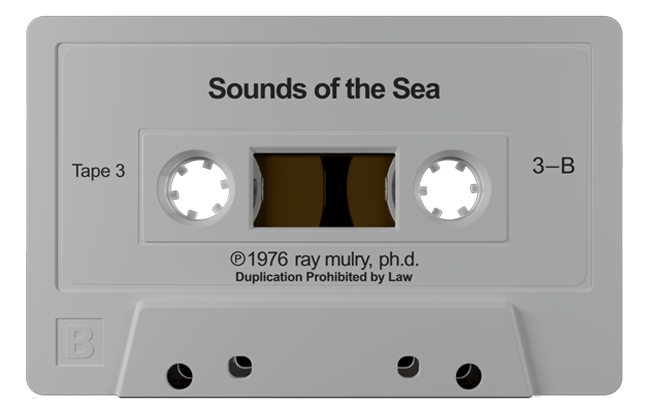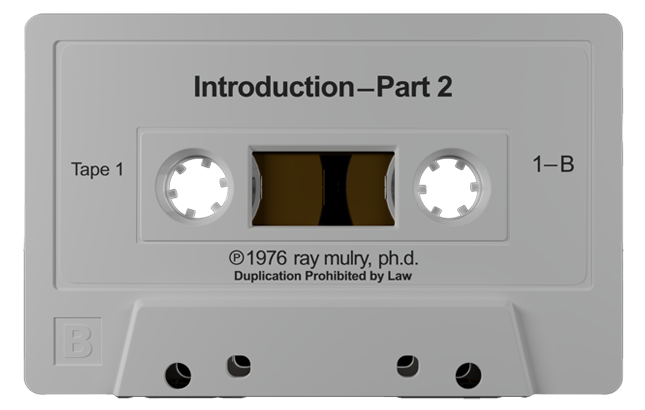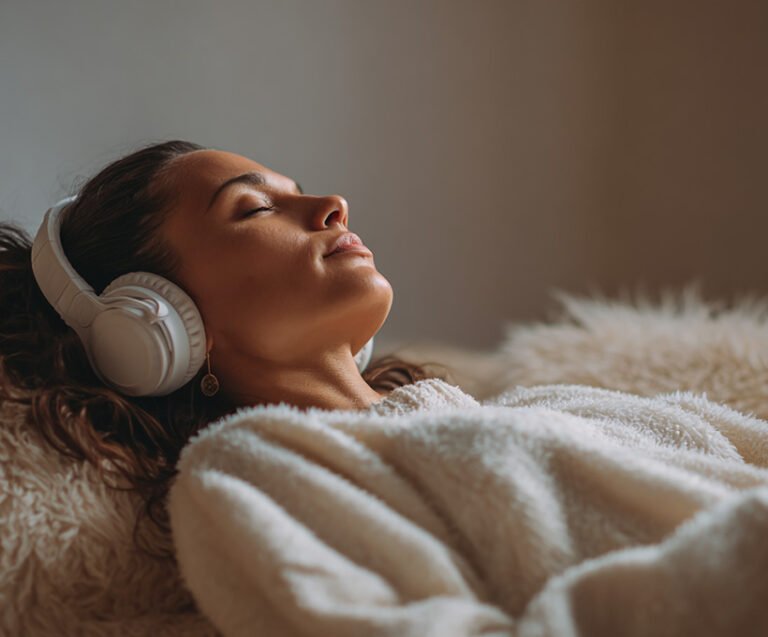Relaxation Therapy is a foundational self-care tool in the Mulry Method. It helps calm the nervous system, release tension, and restore balance through guided meditation.
It supports recovery from stress, anxiety, and chronic tension. By reducing nervous system overload, this practice promotes clarity, restores focus, and lays the foundation for self-directed healing—core principles of the Mulry Method, and consistent with NIH-recommended relaxation techniques.
“We live in a Tension Epidemic, and it is probable this cultural malady is apparent in your personal life… Tension Management is for those individuals who care to help themselves.”
—Dr. Ray Mulry
▶️ Begin Your Relaxation Practice Now
Choose from a range of guided meditations designed to help you release tension, restore balance, and reconnect with a calmer state of mind.
Browse the full collection → to find the version that works best for you. For the best experience, use headphones and a quiet space.
New to this practice? Keep reading to understand how and why Relaxation Therapy works.

What is Relaxation Therapy (RT)?
Relaxation Therapy is a guided meditation practice developed in 1976 as a structured self-care tool. It was first introduced as a series of four audiocassettes and draws on earlier techniques like Progressive Relaxation, created by Dr. Edmund Jacobson in the 1930s, and Dr. Herbert Benson’s Relaxation Response, which explored the physiological benefits of meditation, as described in Harvard Health’s overview.
What distinguishes the Mulry Method’s approach is its emphasis on rhythmic flow throughout the 15-minute induction. Soothing natural sounds and repeating patterns enhance the effect, supporting nervous system regulation and a deepened state of calm.
🎧 Experience Stage 1 Of Relaxation Therapy
Relaxation Therapy is best understood through experience. It follows a three-stage structure designed to guide you into deep, sustained relaxation.
This audio sample offers the first two minutes of Stage 1, a foundational breathing exercise that helps prepare your body and mind for the full relaxation process.
Press play to try it for yourself. For the best experience, use headphones. Then continue reading below to learn how Relaxation Therapy can transform your well-being.
What is Relaxation?

Dr. Mulry defined relaxation as an active process of “letting go” into a flowing rhythm—a parasympathetic nervous system adaptation to an external, soothing rhythm. This definition highlights that relaxation is not passive, but a skill to be practiced.
Before developing Relaxation Therapy, Dr. Mulry was a modern jazz percussionist. His background in rhythm shaped the method’s emphasis on active rhythmic flow, a core part of the relaxation induction process.
The goal of Relaxation Therapy is to help participants build these relaxation skills through repetition. For Dr. Mulry, managing physical tension was a key aspect of self-care—and relaxation skills were essential to achieving that.
How To Practice Relaxation Therapy With The Mulry Method

To practice Relaxation Therapy effectively, start by preparing your environment and finding a comfortable position. Here’s how:
✅ Choose a Quiet Space
Select a calm, quiet room where you’re unlikely to be interrupted. A dim or dark setting supports a more relaxed state.
✅ Find a Comfortable Position
- Lie on your back or sit in a supportive chair.
- Close your eyes and allow your body to settle.
- Avoid using a pillow under your head unless needed—this keeps your spine aligned.
- Place a pillow under your knees to reduce strain on your lower back and hips.
✅ Stay Warm and Undistracted
- Use a blanket or drape to stay warm, as body temperature may drop slightly during relaxation.
- Use Do Not Disturb mode on your phone to avoid interruptions while listening.
- Be aware of other potential distractions—like bright lights, background noise, or uncomfortable clothing—and adjust your environment to support full relaxation.
By creating the right environment and ensuring physical comfort, you’ll be able to fully experience the calming benefits of Relaxation Therapy.
Relaxation Therapy: The Three Basic Stages
Relaxation Therapy consists of three distinct stages, each designed to guide you toward a deeper state of relaxation and self-awareness. Here’s a breakdown of each stage:
1. Breathing Exercises
The first stage uses basic stomach breathing techniques to help you settle in.
- Stay Comfortable: Avoid straining. Go at your own pace and don’t worry about following the speaker perfectly.
- Let Your Mind Wander: Don’t force focus. If your thoughts drift, let them. Effortlessness is key to relaxation.
- Technique: Inhale through your nose, expanding your stomach (not your chest) for deeper breathing. Avoid pulling in your stomach, which restricts lung capacity.
- Guided Breaths: You’ll typically be led through five deep breaths. Complete all five unless you have a physical limitation. Relax into your natural rhythm.
2. Muscle Relaxation
The second stage releases physical tension through guided prompts.
- Follow the Guide: Let the speaker lead. Don’t overthink or try too hard.
- Let It Happen: Even passive listening helps. The goal is gentle release—not perfect concentration.
3. Meditation and Dreamlike States
This final stage encourages mental freedom and deep rest.
- Embrace Freedom: Once physically relaxed, allow your mind to drift. Images, thoughts, or memories may surface—let them.
- Dreamlike State: You might enter a dreamlike state or fall asleep. That’s natural, especially when tired.
- Self-Awareness: Emotions or memories may arise. View them as part of a healing, self-reflective process.
🧭 When To Seek Guidance
If memories or emotions that surface during Relaxation Therapy feel overwhelming, it’s okay to seek help. A qualified mental health professional can support you in processing these experiences and guide you through deeper self-reflection in a safe, constructive way.
🌞 Positive Outcomes
For most people, the second and third stages of Relaxation Therapy are both enjoyable and deeply beneficial. These experiences often lead to greater self-awareness, emotional clarity, and a lasting sense of calm. Whether you recall vivid images or simply drift into peaceful stillness, Relaxation Therapy offers a meaningful way to reconnect with your inner self.
Six Version Of Relaxation Therapy
In all six versions of Relaxation Therapy, the breathing and muscle relaxation stages remain consistent. The third stage varies, offering a range of experiences to suit your personal preferences.

1. Imagination and Meditation
Introduces the dreamlike process in a structured way. This version encourages personal imagery and reflection to promote self-exploration. If you struggle to let your mind wander at first, be patient—the effect grows over time.

2. Gentle Rainfall
Features the soothing rhythm of rain. For many, it enhances relaxation and evokes calming imagery. However, personal reactions vary—explore how this version resonates with you.

3–5. Nature-Inspired Sounds
These tapes include a variety of natural sounds designed to stimulate imagery and relaxation. Each may trigger different emotions or memories. Some will feel more effective than others—let your preferences guide you.

6. A Quiet Place
The most minimalistic version. With no external sound cues, it relies entirely on your ability to let your mind wander. This can be more challenging, so it’s best explored after you’re familiar with the other versions.
🧩 Personal Preferences and Exploration
Each person’s response to the Relaxation Therapy tapes will vary, shaped by personal tastes, associations, and experiences. You may find yourself returning to certain versions more than others—or skipping a few altogether.
Let your preferences guide you. The variety within the series allows you to create a relaxation program that fits your unique needs. That flexibility is what makes Relaxation Therapy a truly personal and adaptable practice.
🎤 Foundational Recordings
These introductory tapes provide valuable context for understanding the principles of Relaxation Therapy. They are packed with information, and their length means they may require patience and focused listening to fully absorb the insights they offer.

Introduction Part 1
A reflective monologue from Dr. Mulry on the stress and tension challenges of 1976—many still relevant today. Offers deep insight into the need for self-awareness and inner calm.

Introduction Part 2
Builds on Part 1 with an overview of Relaxation Therapy’s key principles and techniques. A helpful starting point for newcomers.
🔊 Beyond The Original Recordings
Carefully crafted and sonically distinct, these recordings offer refined listening experiences that deepen the original Relaxation Therapy practice.

Trust Your Swing (2007)
Designed for golfers, this version mimics the rhythm of a smooth golf swing. Its flowing, pendulum-like sound offers a calming experience—even for non-golfers.

Remastered Tapes
An Evening with Nature and Sounds of the Sea have been enhanced with updated effects and significantly improved audio quality.
A Note From Dr. Mulry
I first published and copyrighted RT in 1976, and it was included in my self-published book and audiocassette program, Tension Management & Relaxation Therapy: An Approach To A Balanced Way of Living.
CV Mosby / Times Mirror, a leading medical publisher worldwide, bought the rights to RT in 1980 when we again published the same audiocassette program and included RT in our forthcoming Mosby Publications, The Back School and The Portable Back School.
I coined the term Relaxation Therapy, and it is the original RT. There are now hundreds of RT versions, but mine was the first and has been an enduring product since 1976.
People asked me why I called it Relaxation “therapy,” and I responded, “Because it is the therapy of the future,” which has since proven true.
The Mulry Method Relaxation Therapy is a precise process similar to hypnosis induction. We build upon a rhythmic structure, even when the “Sounds of the Sea” are harmonized with the preceding Relaxation Therapy induction.
I traveled thousands of miles and spent hundreds of hours finding the right sounds of the sea, and I have never told anyone where the recording took place. This is primarily because I want the sea to be your sea in your special fantasy/memory environment.
Listen to these as often as you like; they will center you, give you deep focus, and get you In The Zone.
The History of Relaxation Therapy
Clinical Psychologist Reaume Carroll Mulry, Ph. D., introduced Relaxation Therapy (RT) in the 1970s after one year of pre-production work. The completed work was then copyrighted as a published sound recording on June 24, 1976, registration number 34521.
On December 18, 1980, Dr. Mulry assigned and transferred the same copyright to The C.V. Mosby Company of the City of St. Louis, State of Missouri (medical publishing company now Elsevier) to be included in Dr. Mulry’s forthcoming publications with C.V. Mosby known as Tension Management & Relaxation: An Approach To A Balanced Way of Living and The Back School: A Team Approach To A Balanced Way of Living.
At this time, Dr. Mulry was in private practice as a Clinical Psychologist and was a member of the Associated Medical Staff of the Eisenhower Medical Center in Rancho Mirage, California. Relaxation Therapy was first publicly recognized by the magazine, ‘Los Angeles.’ Relaxation Therapy, Dr. Mulry’s relaxation tapes, were privately acknowledged in a letter of appreciation by George H.W. Bush, 41st President of the United States of America.
Relaxation Therapy in Print and Audio Publications
Dr. Mulry embedded Relaxation Therapy as a fundamental component of his later works, including books and human development programs. Among these are:
- Tension Management & Relaxation: An Approach to a Balanced Way of Living, published by C.V. Mosby-Times Mirror (1981)
- The Back School: A Team Approach to Low Back Pain, published by C.V. Mosby-Times Mirror (1981) and co-authored by White, A., Mulry, R.C., Mattmiller, W.
- The Portable Back School: Home-study Approach to Proper Back Care authored by Mulry, R.C. and White, A. (1981)
- Freedom From Back Pain (1984) authored by Mulry, R.C., published by Nightingale-Conant Corporation
Relaxation Therapy provided the foundation for the audio CD Trust Your Swing: The Power of the Pendulum and Rhythmic Flow (2004), authored by Mulry, R.C. & Mohr, K., published by American Network Services, Inc. (A Nevada Corporation).
First Aid for Back Pain (2009), authored by Mulry, R.C., published by PureSafety (Occupational Health and Safety Training Organization), as an online training program.
Later in Dr. Mulry’s career, Relaxation Therapy became a fundamental component of his In The Zone multi-media sports psychology training program, which identified the 4-Core Competencies of Winning Athletes (i.e., relaxation, balance, flexibility, and focus). The Arizona Daily Sun article “Finding ‘the Zone’” reported that being at the top of your game and in the zone is built on these four key concepts. Dr. Mulry emphasizes the importance of relaxation training, which is key to preventing injuries and stress management.
🧘♀️ Ready to Get Started?
Relaxation Therapy is designed to be simple and accessible. Whether you’re new to guided meditation or returning to a self-care practice, you can begin at your own pace.
👉 Browse the full Relaxation Therapy collection to choose the version that feels right for you.
🔗 Continue Exploring
To explore further, read our blog post Tension Management and Relaxation for a natural approach to stress relief, or visit the Relaxation Therapy FAQ to find answers about technique, timing, and effectiveness.
5-Step Method: Internal Locus of Control
Build confidence, personal responsibility, and lasting change with a proven five-step process designed to strengthen your internal locus of control and guide your self-directed growth.




